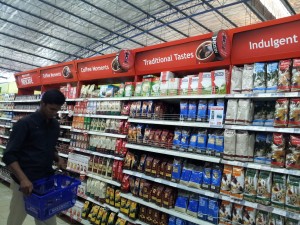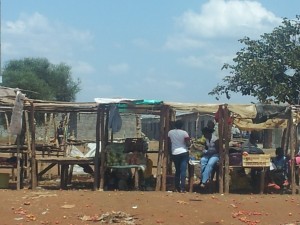“GDP is not the best way to determine whether or not to go into an African country“, the founder of a successful Nigerian company with operations across the continent told me. This wisdom also applies to launching a consumer brand in Africa. Nielsen’s recent report “Africa: How to navigate the retail distribution labyrinth” confirms this.

According to conventional wisdom a consumer brand in Africa or elsewhere will succeed in a market with a stable business environment, and where the population and GDP are experiencing positive growth. Allen Burch, head of Africa for Nielsen, challenges this idea claiming that macro-economic indicators need to be complemented with detailed consumer, retail, and business data .
In particular, the report suggests that succeeding in sub-Saharan Africa (SSA) requires understanding of:
(1) Who shops where: the majority of sales in SSA take place through traditional retail outlets such as the kiosk and table top . The percentage varies by country, but these figures can give us some indication: in South Africa (the SSA country with the most modern trade), 40% of sales come from traditional retail outlets; this goes up to roughly 90% for the rest of SSA.
(2) Who shops for what: Sub-Saharan African consumers have a strong preference for products they are familiar with or that come recommended by someone they trust. Willingness to try new products varies from country to country. In Q3 2014 the willingness of Nigerian consumers to try new products was 73% while for Ghanaians it was 53%.
(3) Which are the right retailers: A small proportion of African retail outlets can account for a disproportionate amount of sales. For instance, Nielsen’s data for African consumers shows that in Lagos, laundry detergents can be found in 100,000 outlets, but that 80% of detergent sales come from 35,000 of those outlets, and 50% from just 10,000 retail outlets. This has implications for both designing the marketing structure and organizing the supply chain.

(4) How to create retailer and consumer demand: understanding how traditional retailers work is key. For instance, it’s quite common to sell by units instead of multi-unit packages. Product packaging needs to take this into account: if the retailer opens a pack and splits the items in it, brand identity may be lost.
A middle class Nigerian once said to me, “Why would we go to one of these modern supermarkets? We can get the stuff we need much cheaper at the next door lady’s shop”
Any experiences with navigating the retail distribution labyrinth in SSA countries?
On a different note, my condolences to the families of the passengers and crew lost in the plane crash yesterday. My thoughts and prayers go out to them.


africa is a difficult business environment to navigate. very helpful insights you have there
Thank you, Shela! I’m gald you find the blog useful. And thank for your comments.
Most families from compounds organise their food on a daily basis.
Although storing stuff is very difficult, sometimes the shop next door is the only one with a fridge.
Though I observed, when you bring something (like food) into these extended families, it will be shared immediately among its members.
There is a very high social pressure on sharing everything you have. Also these family systems are very hierarchical.
You better hide your stuff against the elder members of the family, otherwise some elder brother could take everything from you.
A way to overcome this pressure, and not to go broke, ore be seen as a person with no heart, is to only buy small units.
Modern distribution is fit for the up-coming middle class. Most people can’t afford to pay extra for it.
If interested, you may find some related discussions at https://blog.iese.edu/africa/2014/09/10/personal-care-products-booming-in-east-africa/